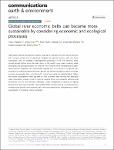Global river economic belts can become more sustainable by considering economic and ecological processes
| dc.contributor.author | Wang, Y | |
| dc.contributor.author | Ni, J | |
| dc.contributor.author | Wan, J | |
| dc.contributor.author | Xu, J | |
| dc.contributor.author | Zheng, C | |
| dc.contributor.author | Borthwick, AGL | |
| dc.date.accessioned | 2024-01-24T10:52:23Z | |
| dc.date.available | 2024-01-24T10:52:23Z | |
| dc.date.issued | 2024-01-05 | |
| dc.identifier.issn | 2662-4435 | |
| dc.identifier.issn | 2662-4435 | |
| dc.identifier.other | 18 | |
| dc.identifier.uri | https://pearl.plymouth.ac.uk/handle/10026.1/21934 | |
| dc.description.abstract |
High-quality regional development requires coupling of socioeconomic and natural domains, but it remains unclear how to effectively integrate the regional economy with river basin ecosystems. Here we establish a developmental perspective of 65 river economic belts, formed through history along the main stems of the world’s great rivers, covering initial, developing, and developed stages. We find that river economic belts characterized by basin-based regional integration can substantially upgrade their eco-efficiency through the harmonization of enhanced regional economic growth and efficient utilization of basin resources, once key prerequisites (e.g., gross domestic product per capita, de-industrialization status, and human development index) are met for river economic belts entering the developed stage. Importantly, primary concerns such as resource stress, environmental pollution, and biodiversity loss are also inherently addressed. Under representative scenarios of regional development planning and climate change (2015–2050), the basin-based regional integration strategy would provide river economic belts with new opportunities and pathways towards sustainability in emerging regions worldwide. | |
| dc.format.extent | 18- | |
| dc.language | en | |
| dc.publisher | Springer Science and Business Media LLC | |
| dc.subject | 37 Earth Sciences | |
| dc.subject | 41 Environmental Sciences | |
| dc.subject | 4104 Environmental Management | |
| dc.subject | 9 Industry, Innovation and Infrastructure | |
| dc.title | Global river economic belts can become more sustainable by considering economic and ecological processes | |
| dc.type | journal-article | |
| dc.type | Article | |
| plymouth.issue | 1 | |
| plymouth.volume | 5 | |
| plymouth.publication-status | Published online | |
| plymouth.journal | Communications Earth & Environment | |
| dc.identifier.doi | 10.1038/s43247-023-01189-3 | |
| plymouth.organisational-group | |Plymouth | |
| plymouth.organisational-group | |Plymouth|Faculty of Science and Engineering | |
| plymouth.organisational-group | |Plymouth|Faculty of Science and Engineering|School of Engineering, Computing and Mathematics | |
| plymouth.organisational-group | |Plymouth|REF 2021 Researchers by UoA | |
| plymouth.organisational-group | |Plymouth|Users by role | |
| plymouth.organisational-group | |Plymouth|Users by role|Academics | |
| plymouth.organisational-group | |Plymouth|REF 2021 Researchers by UoA|UoA12 Engineering | |
| plymouth.organisational-group | |Plymouth|REF 2028 Researchers by UoA | |
| plymouth.organisational-group | |Plymouth|REF 2028 Researchers by UoA|UoA12 Engineering | |
| dcterms.dateAccepted | 2023-12-19 | |
| dc.date.updated | 2024-01-24T10:52:23Z | |
| dc.rights.embargodate | 2024-1-27 | |
| dc.identifier.eissn | 2662-4435 | |
| rioxxterms.versionofrecord | 10.1038/s43247-023-01189-3 |


